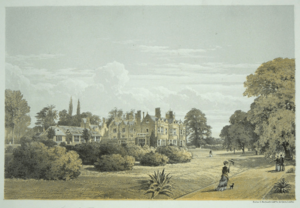The Frythe facts for kids
The Frythe is a large country house in Hertfordshire, England. It is near the village of Welwyn, about 30 miles north of London. This historic building has a long and interesting past. It has been a family home, a secret wartime factory, and a place for important scientific research.
Contents
History of The Frythe
Early Owners and Building
The land where The Frythe stands was once owned by a priory (a type of monastery). In 1523, a man named William Wilshere leased the land. After monasteries were closed down in England, the property was given to Sir John Gostwick in 1539.
Within ten years, William Wilshere bought The Frythe from Gostwick's family. The Wilshere family then owned the property for many centuries.
The current house was built in 1846 for another William Wilshere. He was a Member of Parliament (MP), which means he was elected to represent a part of the country in government. The house was designed in a "Gothic revival" style, which means it looked like older, medieval buildings. After William Wilshere died in 1867, his brother Charles made the house even bigger. The house stayed with the Wilshere family until 1934. Later, it was run as a hotel.
Secret Wartime Operations
In August 1939, just before World War II began, the British military took over The Frythe. During the war, it became a secret factory for the Special Operations Executive (SOE). This secret place was known as Station IX.
At Station IX, experts developed special equipment for commandos. They worked on military vehicles, explosives, and ways to hide things (camouflage). They also researched chemical and biological warfare, though these were very dangerous topics. Small cabins and workshops were built in the grounds of The Frythe to serve as secret laboratories.
Scientific Research Facility
After the war, The Frythe became a place for scientific research. It was used by several large companies over many years.
Unilever's Food Research
From 1946 to 1963, the company Imperial Chemical Industries (ICI) shared the site with Unilever. Unilever built new research buildings in the 1960s. Here, scientists studied edible oils, margarine, ice cream, and frozen foods. They used advanced techniques like X-ray crystallography and nuclear magnetic resonance (NMR) to understand how food works at a tiny level.
GSK's Medicine Discoveries
Later, a company called Smith, Kline & French (now part of GlaxoSmithKline, or GSK) used The Frythe for research. In 1971, scientists at The Frythe discovered a very important medicine called Tagamet (Cimetidine).
This medicine helps treat stomach ulcers. Sir James Black and C. Robin Ganellin were key scientists in this discovery.
Modern Residential Use
The Frythe site was eventually closed by GlaxoSmithKline. It was sold to a company that develops properties in 2010. Since then, The Frythe has been changed into flats and homes.


